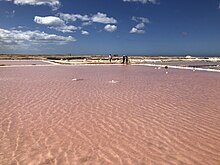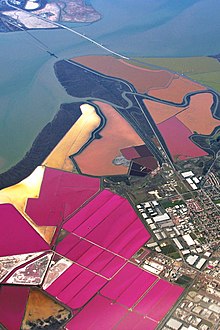
A salt evaporation pond is a shallow artificial salt pan designed to extract salts from sea water or other brines. The salt pans are shallow and expansive, allowing sunlight to penetrate and reach the seawater. Natural salt pans are formed through geologic processes, where evaporating water leaves behind salt deposits. Some salt evaporation ponds are only slightly modified from their natural version, such as the ponds on Great Inagua in the Bahamas, or the ponds in Jasiira, a few kilometres south of Mogadishu, where seawater is trapped and left to evaporate in the sun.
During the process of salt winning, seawater or brine is fed into artificially created ponds from which water is drawn out by evaporation, allowing the salt to be subsequently harvested.
The ponds also provide a productive resting and feeding ground for many species of waterbirds, which may include endangered species. However, Ghanaian fisheries scientist RoseEmma Mamaa Entsua-Mensah also noted that salt winning can destroy mangrove forests and mudflats, altering the environment and making it unproductive for other development or fish growth. The ponds are commonly separated by levees. Salt evaporation ponds may also be called salterns, salt works or salt pans.
Metrics and Energetics

There is an associated loss of available energy when evaporating into dry air. This Gibbs Free Energy becomes positive when the salinity is high enough (or air humid enough) for the salt solution to cause water to condense into it. That is how liquid desiccants work.
Evaporation systems are also often evaluated by the water evaporation rate per unit area. When the energy is largely provided by sunlight, these are often evaluated with a solar efficiency, (), which is a thermal efficiency that compares incoming light energy to the enthalpy of vaporization. This is the same as the gained output ratio (GOR) in desalination .
Algae and color

Due to variable algal concentrations, vivid colors (from pale green to bright red) are created in the evaporation ponds. The color indicates the salinity of the ponds. Microorganisms change their hues as the salinity of the pond increases. In low- to mid-salinity ponds, green algae such as Dunaliella salina are predominant, although these algae can also take on an orange hue. Halobacteria, a type of halophilic Archaea (also known as Haloarchaea), are responsible for changing the color of middle to high-salinity ponds to shades of pink, red, and orange. Other bacteria such as Stichococcus also contribute tints.
Examples
Notable salt ponds include:
- The Salterns of Guérande, in Loire-Atlantique, France. The salt produced in the salterns are a protected geographical indication in Europe.
- The Cáhuil salt ponds, in the O'Higgins Region, Chile.
- The Manaure salt ponds, in La Guajira Department, Colombia.
- The Salineras de Maras, Peru, in the Cusco Region.
- The saltworks of Alcácer do Sal, Comporta, and Castro Marim in Portugal
- The El Caracol solar evaporator, on the outskirts of Mexico City, Mexico.
- The Sečovlje and Strunjan salt ponds on the northern edge of the Adriatic Sea in Slovenia.
- The San Francisco Bay salt ponds in the United States, formerly operated by Cargill, including Charleston Slough. Cargill has since ended salt production in the area, and most of the ponds are being restored to a more natural state.
- South Bay Salt Works in San Diego, California.
- The Dead Sea salt ponds in the West Bank, Israel and Jordan.
- The salt ponds in Salina, Malta. The name of the village is the Maltese word for salt pan.
- The Port Hedland, Dampier, Lake McLeod, Useless Loop and Onslow salt ponds in Western Australia.
- Yellow Walls, Malahide, Ireland; active from 1770 to 1837.
- Lake Grassmere in New Zealand
- The ancient salt pans in Marsala and Trapani, Sicily. Salt has been farmed here since the Phoenician period, with archaeological evidence still present in nearby Motya.
- The Nature reserve of Margherita di Savoia, in Apulia, Italy. Known since antiquity, it's one of the largest in Europe. Flamingos often nest in the area.
- The salt works on the island of Great Inagua owned by Morton Salt.
- The salt harvesting by the Tsonga women of Baleni on the Small Letaba River, Limpopo, South Africa.
Until World War II, salt was extracted from sea water in a unique way in Egypt near Alexandria. Posts were set out on the salt pans and covered with several feet of sea water. In time the sea water evaporated, leaving the salt behind on the post, where it was easier to harvest.
Production
Main articles: Open-pan salt making and SalternSalt pans are shallow and open, and metal pans are often used to evaporate brine. They are usually found close to the source of the salt. For example, pans used in the solar evaporation of salt from seawater are usually found on the coast, while those used to extract salt from solution-mined brine will be found near the brine shaft. In this case, extra heat is often provided by lighting fires underneath.
Gallery
-
Natural salt evaporation ponds at Pedra de Lume, Sal island, Cape Verde
-
A salt pan worker in a salt evaporation pond in Tamil Nadu, India.
-
 Salt evaporation ponds at a lithium mine in Argentina. The brine in this salar is rich in lithium, and the mine concentrates the brine in the ponds.
Salt evaporation ponds at a lithium mine in Argentina. The brine in this salar is rich in lithium, and the mine concentrates the brine in the ponds.
-
 Contemporary solar evaporation salt pans on the island of Lanzarote at Salinas de Janubio
Contemporary solar evaporation salt pans on the island of Lanzarote at Salinas de Janubio
-
 Solar evaporation ponds in the Atacama Desert
Solar evaporation ponds in the Atacama Desert
-
Solar evaporation ponds in the Salt Valley of Añana, Spain
-
 Solar evaporation ponds in the Salt Valley of Añana, Spain
Solar evaporation ponds in the Salt Valley of Añana, Spain
-
 Salt evaporation ponds at Pag, Croatia
Salt evaporation ponds at Pag, Croatia
-
 Salt pile in Argentina
Salt pile in Argentina
See also
References
- Davies-Vollum, K. Siân; Wes, Matthew (August 2015). "Shoreline Change and Sea Level Rise at the Muni-Pomadze Coastal Wetland (Ramsar Site), Ghana". Journal of Coastal Conservation. 19 (4). Heidelberg, Germany: Springer Science & Business Media: 515–525. doi:10.1007/s11852-015-0403-y. ISSN 1400-0350. JSTOR 24761156. OCLC 5889482841. Retrieved 27 February 2024.
- Morrison, Philip (November 1978). "Books: The History of Salt, the Rise of the 'Chip' and How the Indians Lost Faith in Their Game". Scientific American. 239 (5). New York, New York: Scientific American, Inc.: 35–36. doi:10.1038/scientificamerican1178-35. ISSN 0036-8733. JSTOR 24955840. OCLC 9986402667. Retrieved 27 February 2024.
- Athearn, Nicole D.; Takekawa, John Y.; and Shinn, Joel M. (2009) Avian response to early tidal salt marsh restoration at former commercial salt evaporation ponds in San Francisco Bay, California, USA, Natural Resources and Environmental Issues: Vol. 15, Article 14.
- Ashon, Enimil (10 March 2017). "The Woman Who Saw Tomorrow". The Graphic. Accra, Ghana. Archived from the original on 25 February 2024. Retrieved 27 February 2024.
- ^ Fattahi Juybari, Hamid; Parmar, Harsharaj B.; Rezaei, Mohammad; Nejati, Sina; Oh, Jinwoo; Alsaati, Albraa A.; Camacho, Lucy Mar; Warsinger, David M. (2024-10-11). "Unifying Efficiency Metrics for Solar Evaporation and Thermal Desalination". ACS Energy Letters. 9 (10): 4959–4975. doi:10.1021/acsenergylett.4c02045. ISSN 2380-8195. Retrieved 2024-12-24.
- Napa Salt Pond Complex Archived 2011-08-19 at the Wayback Machine, The Bay Institute
- Salt ponds, South San Francisco Bay, NASA Earth Observatory
- "NASA Helps Reclaim 15,100 Acres Of San Francisco Bay Salt Ponds". Space Daily. Moffett Field. July 14, 2003.
- "Cargill Salt - San Francisco Bay". Archived from the original on 2011-08-07. Retrieved 2011-08-09.
- "The Salt Works". 19 July 2011.
- "Baleni Cultural Camp". African Ivory Route. Transfrontier Parks Destinations. Retrieved 11 September 2019.
- Salt, Grown On Sticks Harvested From Sea, Popular Science, March 1933
Video
- Short BBC documentary on the salt evaporation ponds of Pedra de Lume, Cape Verde
External links
- NASA page on salt ponds
- Information on the San Francisco Bay salt ponds
- Interactive satellite view
- "Salt, Grown On Sticks Harvested From Sea" Popular Science, March 1933
| Salt | |
|---|---|
| History | |
| Types |
|
| Food usage | |
| Commerce and industry | |
| By region | |
| Culture | |
| Miscellaneous | |
 ), which is a
), which is a 